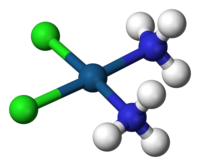
Photo from wikipedia
Three azobenzenes CN(C6H4)-NN-(C5H4N) (py-iso), CN(C6H4)-NN-(C6H4)CN (cyano-iso) and CN(C6H4)-NN-(C6H4)NC (iso-iso) with good coordinating groups (pyridine, phenylcyano or phenylisocyano) at the ends of the diazenyl unit have been synthesized and fully characterised.… Click to show full abstract
Three azobenzenes CN(C6H4)-NN-(C5H4N) (py-iso), CN(C6H4)-NN-(C6H4)CN (cyano-iso) and CN(C6H4)-NN-(C6H4)NC (iso-iso) with good coordinating groups (pyridine, phenylcyano or phenylisocyano) at the ends of the diazenyl unit have been synthesized and fully characterised. These compounds have been used as ligands in the synthesis of water-soluble metallic species by coordination to {FeII(CN)53-} units, either in one or two of the anchoring groups of the derivatives. Both the azo derivatives and their complexes are photochemically active with respect to their trans-to-cis isomerisation process. Their cis-to-trans reverse thermal reaction has been thoroughly studied as a function of the donor groups, solvent, temperature and pressure, in order to gain insight into the rotation or inversion mechanisms involved in the process. A comparison of the isomerisation mechanism between the iron complexes and the corresponding free ligands revealed an interesting fine tuning of the process on coordination of the {FeII(CN)53-} moieties, which may even produce, in some cases, non-photoswitchable species containing typically photoactive units.
Journal Title: Dalton transactions
Year Published: 2023
Link to full text (if available)
Share on Social Media: Sign Up to like & get
recommendations!